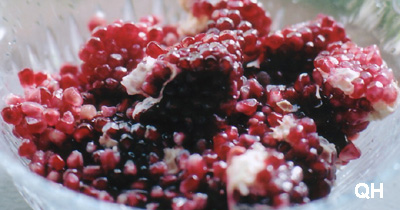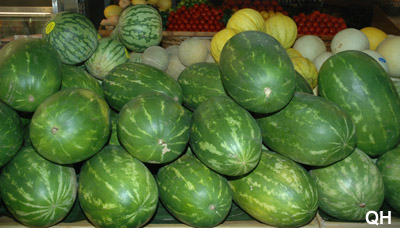
|
By: Massoume Price Culture of Iran Shab e Cheleh /Yalda Festival (The Night of the Fortieth) Yalda, a Syriac word imported into the Persian language by the Syriac Christians means birth (tavalud and melaad are from the same origin). It is a relatively recent arrival and it was very likely refereed to the birth of Jesus Christ (Melaad e Massih) in the past. It is used interchangeably with 'Shab e Cheleh', a Zoroastrian celebration of Winter Solstice around December 21st. Forty days before the next Persian festival 'Jashn e Sadeh': this night has been celebrated in countless cultures for thousands of years. The ancient Roman festivals of Saturnalia (God of Agriculture, Saturn) and Sol Invicta (Sun God) are amongst the best known in the Western world. In most ancient cultures, including Persia, the start of the solar year has been marked to celebrate the victory of light over darkness and the renewal of the Sun. For instance, Egyptians, four thousand years ago celebrated the rebirth of the sun at this time of the year. They set the length of the festival at 12 days, to reflect the 12 divisions in their sun calendar. They decorated with greenery, using palms with 12 shoots as a symbol of the completed year, since a palm was thought to put forth a shoot each month. The Persians adopted their annual renewal festival from the Babylonians and incorporated it into the rituals of their own Zoroastrian religion. The last day of the Persian month Azar is the longest night of the year, when the forces of Ahriman are assumed to be at the peak of their strength. While the next day, the first day of the month 'Day' known as 'khoram rooz' or 'khore rooz' (the day of sun) belongs to Ahura Mazda, the Lord of Wisdom. Since the days are getting longer and the nights shorter, this day marks the victory of Sun over the darkness. The occasion was celebrated in the festival of 'Daygan' dedicated to Ahura Mazda, on the first day of the month 'Day'.  Fires would be burnt all night to ensure the defeat of the forces of Ahriman. There were feasts, acts of charity and a number of deities were honored and prayers performed to ensure the total victory of sun that was essential for the protection of winter crops. There would be prayers to Mithra (Mihr) and feasts in his honor, since Mithra is the Eyzad responsible for protecting 'the light of the early morning', known as 'Havangah'. It was also assumed that Ahura Mazda would grant people's wishes, specially those with no offspring had the hope to be blessed with children if performed all rites on this occasion. One of the themes of the festival was the temporary subversion of order. Masters and servants reversed roles. The king dressed in white would change place with ordinary people. A mock king was crowned and masquerades spilled into the streets. As the old year died, rules of ordinary living were relaxed. This tradition persisted till Sassanian period, and is mentioned by Biruni and others in their recordings of pre-Islamic rituals and festivals. Its' origin goes back to the Babylonian New Year celebration. These people believed the first creation was order that came out of chaos. To appreciate and celebrate the first creation they had a festival and all roles were reversed. Disorder and chaos ruled for a while and eventually order was restored and succeeded at the end of the festival. The Egyptian and Persian traditions merged in ancient Rome, in a festival to the ancient god of seedtime, Saturn. The Romans exchanged gifts, partied and decorated their homes with greenery. Following the Persian tradition, the usual order of the year was suspended. Grudges and quarrels were forgotten, wars were interrupted or postponed. Businesses, courts and schools were closed. Rich and poor became equal, masters served slaves, and children headed the family. Cross-dressing and masquerades, merriment of all kinds prevailed. A mock king, the Lord of Misrule, was crowned. Candles and lamps chased away the spirits of darkness. Another related Roman festival celebrated at the same time was dedicated to Sol Invictus ("the invincible sun"). Originally a Syrian deity, the Roman Emperor Heliogabalus imported the cult in to Rome and Sol was made god of the state. With the spread of Christianity, Christmas celebration became the most important Christian festival. In the third century Christians celebrated various dates, from December to April for Christmas. January 6 was the most favored day because it was thought to be Jesus' Baptismal day (in the Greek Orthodox Church this continues to be the day to celebrate Christmas). In year 350, December 25 was adopted in Rome and gradually almost the entire Christian Church agreed to that date, which coincided, with Winter Solstice and the festivals, Sol Invicta and Saturnalia. Many of the rituals and traditions of the pagan festivals were incorporated into the Christmas celebration and are still observed today. It is not clear when and how the word 'Yalda' entered the Persian language. Iran had a large Christian population. Territories like Armenia that was part of the Persian Empire for centuries were entirely Christian along with other border countries and parts of Byzantine City States continuously changing hands between Persia and Anatolia. The massive persecution of the early Christians in Rome and the later sectarian wars between different Christian sects during the Byzantium era brought many Christian refugees into the Sassanid Empire and it is very likely that these Christians introduced and popularized 'Yalda' in Iran. Yalda was their celebration of Christmas. Gradually 'Shab e Yalda' and 'Shab e Cheleh' became synonymous and the two are used interchangeably. With the conquest of Islam the religious significance of both Christmas and the ancient Persian festival was lost. Today 'Shab e Cheleh' is merely a social occasion, when family and friends get together for fun and merriment. Different kinds of dried fruits, nuts, seeds and fresh winter fruits are consumed. The presence of dried and fresh fruits is reminiscence of the ancient feasts to celebrate and pray to the deities to ensure the protection of the winter crops. Medieval poetry from Hafez is read and fortunes are sought through the interpretation of his poems. This extremely popular poet lived in the 14th century, his poetry is found in almost every household. It is a tradition to make a wish, then open a page randomly and start reading the first poem on that page. Interpretations of the poem are used to decide whether the wish will come true or not. Before the coming of TV and other mass media it was customary for the grandparents to tell popular old stories to their grandchildren on this night.  Family members gathered around and under a uniquely designed short wooden table covered with large quilts and blankets. A small charcoal fire was prepared in a fire resistant open container with ashes on top to regulate and control the burning charcoal. This was placed under the table and all members would curl under, kept warm even ate and slept there. The table is called 'corsi' and was very popular till recently. Electricity and more efficient heating systems have eliminated corsi as a heating alternative. However many traditional families still use modern electrical versions of it and the tradition is kept alive. Curling under corsi, listening to grandparents telling ancient and magical stories eating fruits, nuts etc. is associated with shab e cheleh and was part of every Iranian's growing up memories till recently. The Iranian Jews, who are amongst the oldest inhabitants of the country, in addition to 'Shab e Cheleh', also celebrate the festival of 'Illanout' (tree festival) at around the same time. Their celebration of Illanout is very similar to Shab e Cheleh celebration. Candles are lit; all varieties of dried and fresh winter fruits will have to be present. Special meals are prepared and prayers are performed. There are also very similar festivals in many parts of Southern Russia that are identical to 'Shab e Cheleh' festival with local variations. Sweet breads are baked in shape of humans and animals. Bon fires are made; dances are performed that resemble crop harvesting. Comparison and detailed studies of all these celebrations no doubt will shed more light on the forgotten aspects of this wonderful and ancient festival, where merriment was the main theme of the festival.  Back to top Back to top Front Page Front Page |